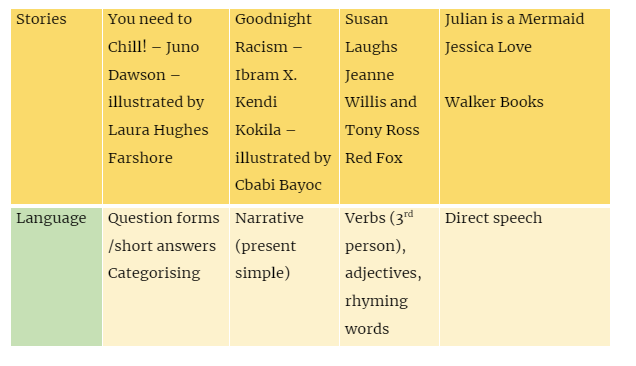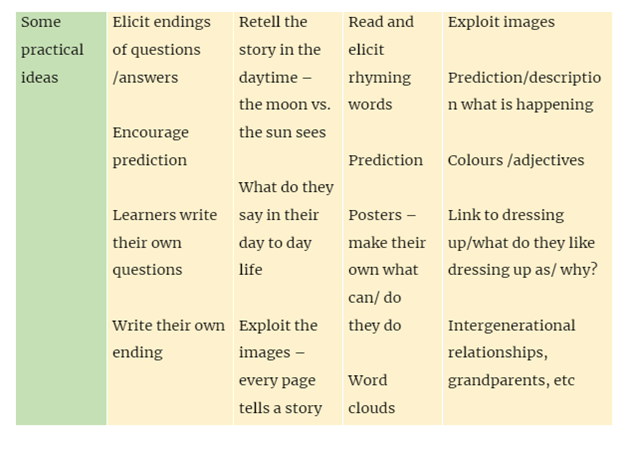Do we need to chill? Thought-provoking storytelling
Do we need to chill? Thought-provoking storytelling
by Xana de Nagy
Like many of you, I love teaching children, and I love storybooks because they make me think about life and interesting topics. In my experience, children like them too and generally ask lots of questions about life, often leading to tricky topics or ‘issues’ coming up spontaneously. Over the years I have come across thought-provoking stories and wanted to use them in the classroom. The problem I have experienced is not ‘how’ to use them (I think most YL teachers can think of a million ways to use stories) but rather ‘if’ we should.
My session at the recent IH YL Conference in Rome reflected on this and in this article, I’m going to share some of the ideas we discussed and some practical ideas for exploring these and other stories in the Young Learner classroom.
I chose four stories to focus on. You may be familiar with them. If you are, I hope you like them as much as I do. If not, I highly recommend reading them. They cover different topics or issues such as aspects of identity, race, cultural differences, gender, and acceptance. The stories that inspired this article are: You need to Chill! by Juno Dawson; Goodnight Racism by Ibram X. Kendi; Susan Laughs by Jeanne Willis and Tony Ross, and Julian is a Mermaid by Jessica Love.
You may agree that some of these topics/ issues can be controversial in some contexts, so should we as English Language teachers be dealing with them in the classroom? In researching for the session, I came across many different reviews of these stories, written by parents and teachers, some positive and some negative. Generally speaking, though, the comments are that these stories are a good vehicle for discussing some tricky issues with children and that there are subjects in mainstream education that would provide a good opportunity to do just that. But is that opportunity to be found in the ELT classroom?
These are some of the questions that I asked myself:
- Do you, or would you, cover these issues in class? And if not, why, not?
- Is a story a good way to cover them?
- Are some issues easier to deal with than others? Why?
- Does age play a factor? How?
- Is it our place as EFL teachers to address these topics?
- Are these taboo /inappropriate topics in your work context? How do you feel about that?
- Is it mainly to do with cultural implications/restrictions?
- Is it acceptable to discuss these issues in your context?
There are an endless number of ways to categorise children’s stories: the classic fairy tale, popular tales, myths, etc. Some authors talk about ‘issue stories’- however, these are often to do with ‘bad things’ that can happen. In this case, I have used the term ‘issue’ with the neutral meaning, ‘an important topic or problem for debate or discussion’ and have ignored the often negative connotation that comes with the word. In none of these stories, in my opinion, does a ‘bad’ thing happen; in fact they are all very positive and promote ‘good’ things. So, looking at these four books I have grouped them into two types of story:
- Surprise - Those that have a moral and use the surprise/shock factor to try to force a response and, in a way, normalise the issue.
- Matter of fact - Those where the issue is presented as matter of fact; the message is covered in the story but not made explicit.
I think we may all have a favourite type of story, but do you think that children would prefer one over the other? Do you think they need to have the ‘issue’ spelled out or would they prefer to enjoy the story without having a spotlight on the topic?
I recently told one of these stories to a group of primary teachers. The story was one that falls into the category of ‘surprise’. When I got to the end, the general feeling in the group was one of disappointment. They had wanted the story to go in another direction and felt that they wouldn’t be able to use the story in class because of the ‘surprise’ and the issue it covered. I wonder if the children would have felt the same. I think they may have liked the unexpected turn it took.
I believe there are many reasons why it is a good idea to exploit stories like these. They are important as they can help to ‘normalise’ certain issues which children may not otherwise have access to. Children are generally accepting of differences, and we need to use that to our advantage. Real and important issues can be dealt with in a ‘softer’ way. Stories encourage creativity and motivate children and can be used for Social and Emotional learning. Children generally ‘emulate’ their parents and care-givers, and these stories help to provide good role models. It is important for children to see somebody that looks like them, someone they can identify with as this helps them to feel safe and part of society.
I do accept that it can also be problematic as we need to consider if we as teachers are ready to answer all their questions, wherever they take us. Your teaching context needs to be taken into consideration, as not all contexts will be as accepting of these topics. It’s important to consider the ‘audience.’ Who do you have in your classroom? Are you teaching children that come from a more conservative background, whose parents hold views that you know to be different to the ones expressed in the story? The cultural norms of the country or school where you are teaching can also affect your decision. And finally, and perhaps the most important, the parents. Who are we to take their place? They drop their children off at school and expect to collect them having the same belief system they went in with.
The books I chose are just some of the many books out there that deal with many interesting topics. It is true that we could use the books without focusing too much on the issues at hand, although in my opinion, that would be a pity.
But let’s think like ELT teachers- ignoring the ‘topic’ what could you do with the stories? Here are some ideas:


And some talking points inspired by ‘Talk to your kids about…’ from Common Sense Media:
- Do you have festivals in your town?
- Do people dress up? Do you?
- What are they worried about?
- How did their grandmother respond?
- Do you eat together with your family?
- What do you dream about?
- What did you like about the story?
- How is the main character the same as you? How are they different?
- Can you do what they can do?
- Why are the children asking questions?
- What do they want to know?
- Is the main character ok? How do you know?
The general consensus in the session I ran, which had teachers from many different countries, but mostly teaching in the language school context, was that ‘yes’ we should be dealing with these issues, but that the cultural and social constraints often meant that we could not. What about you, what do you think?
Bibliography
Dawson, J and Hughes L, You need to Chill! (2022) Farshore
Kendi, I, and Bayoc C, Goodnight Racism (2022) Kokila
Love, J. Julian is a Mermaid (2018) Walker Books
Willis, J and Ross, T. Susan Laughs (1999) Red Fox
‘Talk to your kids about…’ Common Sense Media
Author Biography
 Xana de Nagy is the IHWO YL Advisor and a teacher/teacher trainer based in Lisbon. She started teaching in 1984 and training in 1990. She spends most of her time working on OTTI and CELTA courses, but has also trained on IHCAM, DELTA, CELT-P and IHCYLT and run sessions for state school teachers. She has always had a special interest in teaching children and has a MSc in TEYL.
Xana de Nagy is the IHWO YL Advisor and a teacher/teacher trainer based in Lisbon. She started teaching in 1984 and training in 1990. She spends most of her time working on OTTI and CELTA courses, but has also trained on IHCAM, DELTA, CELT-P and IHCYLT and run sessions for state school teachers. She has always had a special interest in teaching children and has a MSc in TEYL.
